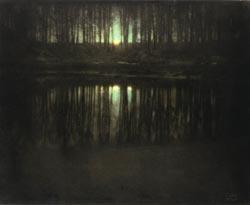A photograph printed in platinum and then modified with the gum bichromate process, has sold for nearly $3 million at Sotheby's.
An image of a moonrise over a lake, printed in platinum and then modified with the gum bichromate process, has sold for nearly $3 million (?1.6 million) at Sotheby’s, New York, setting a new price record for any art photograph.
As the chemist and photography expert Mike Ware reports, the record-breaking print, entitled The Pond - Moonlight, dates from 1904 and is the work of the American artist Edward Steichen (1879-1973).1

While there are three known prints originating from the same negative, the high degree of manual skill required to produce each print, along with the longevity guaranteed by the precious metal, helps to make such works highly desirable in the art world.2
’The platinotype process, invented in 1873 by William Willis of Bromley, Kent, was widespread around 1900, and highly esteemed as the finest method for making beautiful, permanent photographic prints,’ Ware told Chemistry World. ’Platinotype paper was available commercially and only slightly more expensive than the silver halide papers of the day.’
In rare cases, such as the Steichen prints, the original black and white platinum prints were used as a substrate to which further layers with different tones and colours were added.
Steichen applied a solution of gum arabic, a pigment and a dichromate to the print, then exposed the print through a negative once more. Light triggers the reduction of dichromate to Cr(III), which can cross-link the macromolecules of the gum, which then solidifies and traps the pigment. Using this process, several layers incorporating different pigments can be added, turning the original black and white print into a colourful - and valuable - work of art.
Michael Gross
References
Platinum Metals Rev50Platinum Metals Rev49, 190






No comments yet